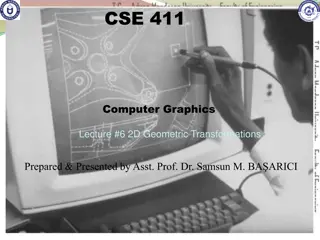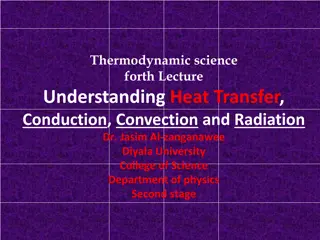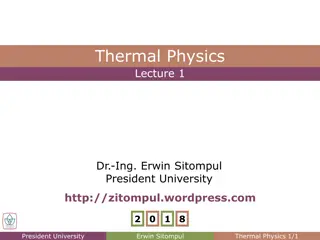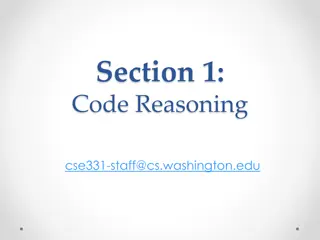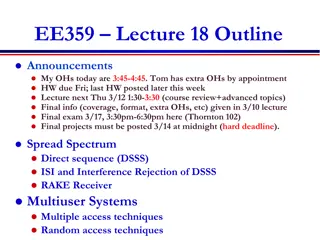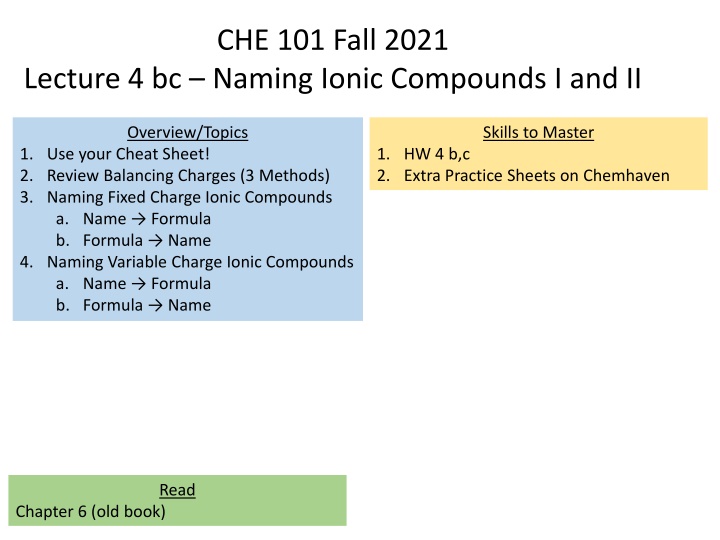
Naming Ionic Compounds: Overview and Skills to Master
Master the naming of fixed and variable charge ionic compounds with the help of cheat sheets, review of balancing charges, understanding compound types, and more. Practice naming compounds and balancing charges to excel in CHE 101 Fall 2021.
Download Presentation

Please find below an Image/Link to download the presentation.
The content on the website is provided AS IS for your information and personal use only. It may not be sold, licensed, or shared on other websites without obtaining consent from the author. If you encounter any issues during the download, it is possible that the publisher has removed the file from their server.
You are allowed to download the files provided on this website for personal or commercial use, subject to the condition that they are used lawfully. All files are the property of their respective owners.
The content on the website is provided AS IS for your information and personal use only. It may not be sold, licensed, or shared on other websites without obtaining consent from the author.
E N D
Presentation Transcript
CHE 101 Fall 2021 Lecture 4 bc Naming Ionic Compounds I and II Overview/Topics Skills to Master 1. Use your Cheat Sheet! 2. Review Balancing Charges (3 Methods) 3. Naming Fixed Charge Ionic Compounds a. Name Formula b. Formula Name 4. Naming Variable Charge Ionic Compounds a. Name Formula b. Formula Name 1. HW 4 b,c 2. Extra Practice Sheets on Chemhaven Read Chapter 6 (old book)
Naming Overview 4 Categories Type of Compound Identify Rules Misc. Ionic - Fixed m/nm Cation Anion E ide Poly - normal Ionic - Variable m/nm Cation (charge) Anion Charge uses Roman Numerals Prefix - 1st E prefix 2nd E Molecular nm/nm Know prefix s Acids H_ Memorize Its only 10 Your CS may be helpful
Using your Cheat Sheet o Never leave home without it o Provided on every exam Fixed Charges Variable Charges Roman Numerals and Molec. Prefixs Polyatomic Ions
Review Ch 3 Know the following: Metalloids (7*) B, Si, Ge, As, Sb, Te, Po/At Metals (left) Non-metals (right)
Review Ch 3 Compound: 2 or more E, chemically combined (bonded) in definite proportions Ionic Covalent or Molecular Gain/lose electrons Formed by Share electrons Between m/nm nm/nm Bond Strength High Low Melting Point High Low Solubility High Low Conductivi ty High Low Structure Lattice Discrete Molecules
Naming Fixed Charge Ionic Compound Metal Anion E - ide Poly = name o Always write ionic compound: Cation Anion (or m/nm) o Naming: Cation = metal name Anion = element change ending to ide Polyatomic = name on CS o Writing Formula Balance Charges NaCl NaNO3 Sodium Nitrate Sodium Chloride MgCl2 Mg2(PO4)2 Magnesium Chloride Magnesium Phosphate Formula to Name
Review of 6a 3 Methods to Balance Charges o Atoms o Old School Math and CA method o Cross Method + Simplify You try it: Compound formed between Ca and N You try it: Compound formed between Na and SO4 Charges are on your CS!
You try it: Compound formed between Ca and PO4 You try it: Compound formed between Al and SO4 You try it: Compound formed between Na and SCN You try it: Compound formed between Ag and HPO4
Method 2 Math + CA Method You try it: Compound formed between Mg and P You try it: Compound formed between K and CO3
You try it: Compound formed between Al and CO3 You try it: Compound formed between Ba and S You try it: Compound formed between NH4+ and NO3 You try it: Compound formed between NH4+ and PO4
Naming Variable Charge Ionic Compounds Metal (charge) Anion o Always write ionic compound: Cation Anion (or m/nm) o Naming: Cation = metal name Charge in ( ) using roman numerals Anion = element change ending to ide = Polyatomic name on CS Variable Charge Listed on CS Roman Numerals on CS VCl3 Fe3(PO4)2 Iron (II) Phosphate Vanadium (III) Chloride VCl5 Fe3PO4 Vanadium (V) Chloride Iron (I) Phosphate
Method 3 Cross Multiply + Simplify You try it: Compound formed between Sn+4 and O You try it: Compound formed between Sn+2 and CO3 Compounds always form in the lowest whole number ratio
You try it: Formula for Lead (IV) Sulfite You try it: Formula for Chromium (III) Hydroxide You try it: Name for Au2(S2O3)3 You try it: Name for Hg(SO4)2
Mix it all up! You try it: Formula for Scandium Oxalate You try it: Formula for Cobalt (II) Oxalate You try it: Name for ZnCr2O7 You try it: Name for Sb(MnO4)5






